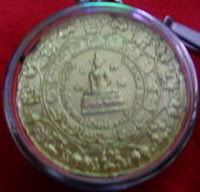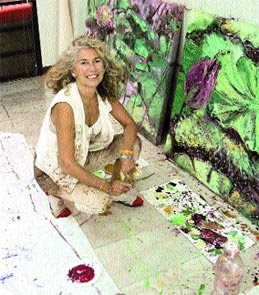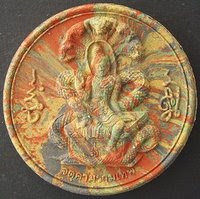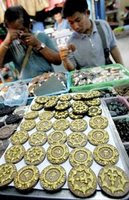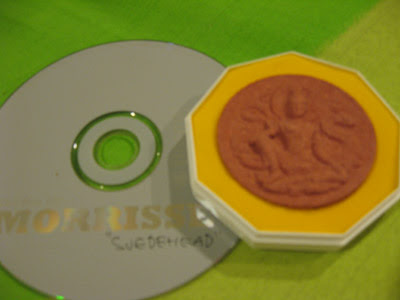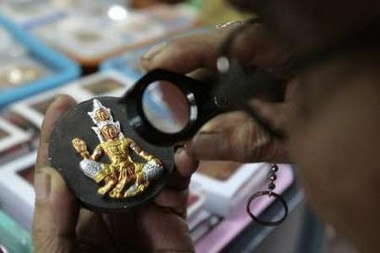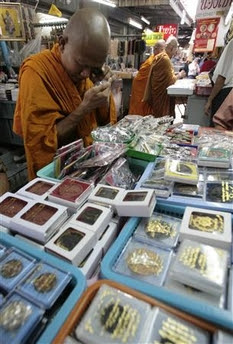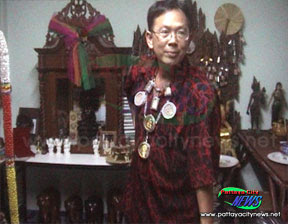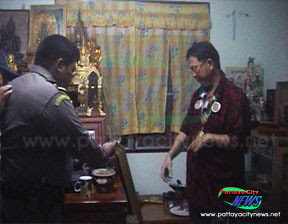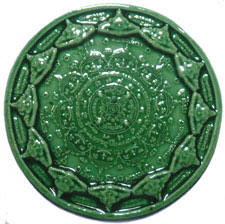The bottom seems at last to have fallen out of the Jatukam market
Demand for Jatukam Ramathep amulets will taper off next year and sales ease to about Bt10 billion, just a quarter of what has been quoted for 2007.
The Jatukam Ramathep bubble may have burst, but it was a craze that ran hot for more than seven years.
In 2000, the combined market value of the amulets, perceived to be sacred, especially if they are anointed at Wat Phramahathat Worrawiharn in Nakhon Si Thammarat province, was around Bt5 billion.
According to Kasikorn Research Centre, the market doubled every two to three years, rising to an estimated Bt10 billion in 2003 and Bt20 billion in 2005.
The sales figure being tossed about for this year is a whopping Bt40 billion.
Now that could be history, and another boom is unlikely any time soon, according to those knowledgeable about auspicious objects.
The reversal of fortune can be attributed to overheated demand forcing up prices. Jatukam Ramathep amulets skyrocketed from just Bt50-Bt100 each to more than Bt2,000 for an "average" example.
In addition, the boom led to mass production of sub-standard amulets. There was frenzied speculation for quick profits, too.
Bang Lamphu amulet-trader Thep, who asked that his family name be withheld, said the boom was "really incredible".
"You only needed a tiny shop here to make tens of thousands of baht a day. The place was overcrowded most of the time.
"Now that's a thing of the past. Today less than 10 customers a day visit a big Jatukam shop. Making money is difficult."
And you can pick up an amulet over the Internet for as little as Bt5. That is a market collapse.
Kasikorn researcher Phaka-on Thipayadecha said the popularity had died.
"The bubble has burst. Demand for amulets is returning to normal, with only those who really have faith wanting them," she said.
The Jatukam Ramathep charms were created at Wat Phramahathat to pay respect to Nakhon Si Thammarat's guardian god and former ruler. The province was at the centre of the former Srivichai kingdom. Jatukam Ramathep was the name of one of its kings.
Former police officer Phantharak Ratchadej created the first amulets.
They started to gain in popularity after tales of miracles spread by word of mouth and Buddhist-amulet magazines.
"It's difficult to explain scientifically, but miracles did happen. People with the amulets survived accidents and murder attempts.
"I personally believe only in Jatukam Ramathep objects," explained Ton, a fourth-year Thammasat University student.
Their fame reached a peak on July 5, 2006 at the funeral of Phantharak. He died aged 108. More than 100,000 believers attended his funeral.
Deep faith could have been behind the feverish demand, but shrewd marketing helped too.
"With Jatukam, we are talking about faith and auspicious objects on the one hand and business and marketing on the other. Look carefully. The four Ps of marketing are all there: product, price, place and promotion," explained Wattanachai Yaninthorn of marketing magazine Positioning.
"As a product, Jatukam was of the highest quality in terms of historic, spiritual and other values. The key messages were very attractive too: helping people get rich and protecting them from evil.
"In price there was a lot of choice, starting at less than Bt100 to over Bt1 million. In place, it was simple to hire tiny stalls in a busy market or a department store from which to sell them.
"In promotion, ads abounded prior to the Jatukam peak, and makers and the Buddhist-amulet media joined forces to spur demand," he explained.
Phaka-on said amulets were now in recession due to sub-standard production and declining faith among buyers.
"This is no surprise, since what we saw this year and last was in no way sustainable. Things moved at very high speed.
"Businesswise, the boom drew many people into the trade, most of whom were new. Then there was a shortage of craftsmen making new series. Now there are sub-standard products. Many buyers have complained about this," she said.
Kasikorn forecast the market would top Bt40 billion this year. Next year it predicts a sharp fall. "But we cannot say for sure by how much," said Phaka-on.
She forecast demand would return to "a more reasonable level, around Bt10 billion a year".
Only real believers will buy, and only competent craftsmen will make them, she said.
Meanwhile, respected monks warn that the amulets are un-Buddhist. Phaka-on said the warnings were unlikely to have a long-term effect on sales because of people's obsession with amulets and auspicious objects.
She is more concerned about consumers being protected from poorly made charms.
Kamol Sukin
The Nation
http://www.nationmultimedia.com/2007/08/26/headlines/headlines_30046522.php
